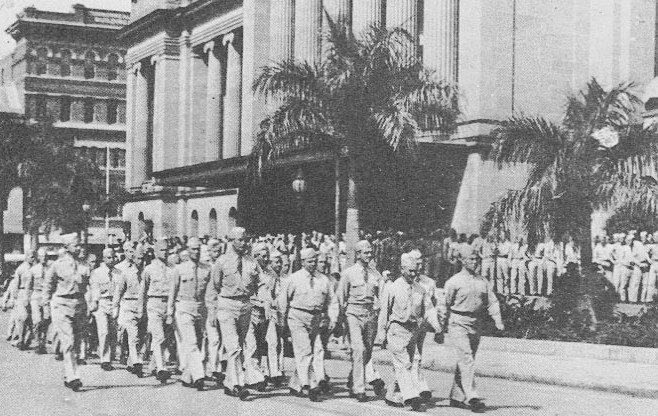Often, the Allied powers during the Second World War are seen as a united front. And obviously, they were, leaving out many caveats and nuances. One example is Australia, a country that allowed American servicemen to set up base in their cities to prepare for the Pacific theatre campaign. There were some fundamental cultural differences between the Americans and Australians, and oddly enough this even led to the infamous Battle of Brisbane between American and Australian service troops. But aside from this battle, an even weirder event led to… well I’d say horrible PR for the Americans. Among their troops stationed in Australia was a serial killer. In contrast to his fellow soldiers preparing an attack on the Japanese Empire, this soldier waged attacks on Australian women. Dubbed the ‘Singing Strangler’, Eddie Leonski was an American serial killer, stationed in Australia during the Second World War.
American-Australian Relations
Australia formally entered what would become the Second World War on September 3rd, 1939. Its government accepted the United Kingdom’s declaration of war on Nazi Germany. And that isn’t too surprising. To many Australians, servicemen and civilians alike, their primary loyalty aside from that to Australia itself, was to Britain. It was part of the Commonwealth and had obvious historical and cultural ties.

Yet, due to how the war progressed in the European Theatre, namely not too good for the allies, Churchill had to make a difficult decision. Australians were, with right, worried about Japanese offensives and perhaps even an attempted invasion. Yet British prime minister Winston Churchill declared that if he had to, he would use British troops to protect Britain, rather than help the Australians against the Japanese. Due to the Japanese attack on Pearl Harbor on December 7th 1941, the United States entered the war. It led to Australian Prime Minister John Curtin to call on the United States’ President Roosevelt for help, a turn of events that surprised many older Australians.
Before the month of December ended, over 4000 American servicemen entered Brisbane, preparing for the Pacific Theatre campaign. Within one year over 250.000 American troops were stationed in Melbourne, Sydney and Brisbane. In total it is estimated that nearly one million soldiers passed through Australia, of whom 80.000 were stationed in Brisbane. By this time, most Australians didn’t travel, let alone to the United States, so Hollywood films mostly shaped their perception of these new servicemen.
American military historian Ian W. Toll writes about the surprise among many Australians. As soon as the curiosity about the waves of Americans subsided, the limits of Australian hospitality were explored. Bribane had around 335.000 inhabitants, so the influx of so many American troops certainly had an impact.
Due to American spending, since they were paid twice as much as Australians, the Australian economy boomed. Unfortunately, it led to pubs selling beer under the counter, overcharging Americans, while telling their Australian customers there wasn’t any left. There were several deadly incidents on the road due to drunk Americans driving on the wrong side. And the smooth-talking, slick Americans were much more popular with Australian women. Newspapers even published articles about Australian women not getting their hopes up once marrying an American soldier, because the country itself wasn’t what it was made out to be in Hollywood films. The fact Americans had sharper uniforms and could afford chocolate and cigarettes, goods Australian servicemen couldn’t easily lay their hands on, and the wooing of Australian girls, inevitably led to conflict.
In addition to these issues on lower levels, U.S. General Douglas MacArthur was stationed in Australia as commander of all Allied forces in the Southwest Pacific. He never hid the fact he thought Australian troops weren’t up to the American standard. There were competent Australian commanders, such as General Sir Sydney Rowell. Rowell was respected among his forces and the public, and he bravely fought, and eventually halted the Japanese advance towards Port Moresby. Yet MacArthur ended up relieving Rowell of his command because, as mentioned earlier, he didn’t think he was up to the task. This inspired a widespread grudge against his person among Australian troops. All these irritations resulted in a powder keg, although a relatively small one.
Eddie Leonski
Considering all this you’d not be surprised American commanders were anxious for bad PR surrounding the U.S. army. Well, what certainly didn’t help was the fact that one of the strangest cases perhaps any nation at war has seen, walked around in Melbourne. 24-year-old American soldier, Eddie Leonski, wasn’t there to protect Australia. At least, not on an individual level. In fact, he preyed on Australian women – he was a serial killer during wartime. Dubbed the Singing Strangler and the Brownout Strangler he killed three women during his service.

Leonski was born in December 1917 at Kenvil, New Jersey, in the United States. He was the sixth child of a Russian émigre family. In 1933 Leonski left highschool, taking a secretarial course which he excelled at. It was surprising that the boy excelled considering his home circumstances: his mother was known to have serious mental health issues. One of his brothers was locked away in a psychiatric ward, and two other brothers had prison records. He worked multiple clerical jobs before he was called up for military service in February 1941.
Initially stationed with the 52nd Signal Battalion at San Antonio, Texas, Leonski developed an unhealthy alcohol habit. According to court proceedings, during this time Leonski attempted to strangle a woman for the first time, yet this wasn’t known until after his final arrest. Because it wasn’t known, Leonski was deployed to Australia in January 1942. He arrived at Camp Pell in Melbourne, where he continued his alcohol habit. Again, according to court proceedings he allegedly raped a woman in her apartment, but the army didn’t find out about it.
Due to his drinking habit, he was locked up thirty days early on during his deployment, but he simply continued his habit upon release. There weren’t any established psychiatric issues known about Leonski, but it’s safe to assume they simply went undetected. One important aspect of his subsequent crimes was that Australia’s wartime reduction of streetlight allowed him to use the cover of darkness.
On May 3rd 1940, 40-year-old Ivy Violet McLeod’s lifeless body was discovered in a doorway near Albert Park, Melbourne. She was throttled and her valuables and purse were left untouched. Detectives quickly established theft wasn’t the motivation. Press dubbed the murder the ‘Brownout Murder’, leading to Leonski’s eventual nickname of the Brownout Strangler.
But he didn’t just take a break. Six days later the 31-year-old Pauline Thompson was strangled after leaving a pub. Upon interviewing witnesses that had been with her the night before, she was accompanied by a man that stood out due to his American accent.
Another week later the body of 40-year-old Gladys Hosking was found. She had been murdered, in the same way the previous two women had, walking home from work. A witness told detectives an American man, covered in mud, asked for directions in the area.

Now, Leonski wasn’t exactly the brightest bulb in the shed. He confided his crimes to another soldier, and in combination with Australian detectives questioning many Americans, eventually, Leonski’s name turned up. In combination with several other witness statements, 24-year-old Leonski was arrested and during a police, lineup witnesses picked him out. He was subsequently charged with the murders of three women. Leonski had a boyish appearance, big smile, was powerfully built and of average height. The only statement he gave about why he murdered the women was that he “wanted their voices.” When newspapers got a hold of this piece of information, Leonski was dubbed the ‘Singing Strangler.’
Due to the case obviously being rather controversial, and Americans standing not being ideal in Australia either, there was much discussion about whether the Australian government or the U.S army should try Leonski. Eventually, the Curtin government decided a United States court-martial should try him. The investigation declared him sane and on July 17 Leonski himself pleaded guilty to the charges.
During his last few months on death row, Leonski corresponded with a woman and became a Catholic Church communicant. On November 9, 1942, he was hanged. His remains are buried in a cemetery for prisoners that died in military custody in Hawaii.
The Battle of Brisbane
Later that same month, another event truly put to the test the Australian-American relations. The general dissatisfaction among Australian troops, who felt disadvantaged to the Americans, in combination with the Leonski case and several smaller riots where American military police singled out Australians made the powder keg explode. All of this led to the infamous Battle of Brisbane. Australian war correspondent John Hinde remarked that the battle of Brisbane was the most furious battle he ever saw during the war. It was like a civil war. Because it wasn’t a fight with the Japanese, but a two-day battle between American military police and G.I.s against Australian soldiers.
On the night of November 26, Thanksgiving Day in the United States, a scuffle unfolded on Brisbane’s streets. Ironically a group of Australian soldiers defended an American serviceman they befriended against the American military police. Private James R. Stein, intoxicated after a night of drinking, was halted by MPS while on his way to the Post Exchange. After exchanging words, things got heated, and surrounding Australian servicemen and civilians jumped in to help Stein against the MPs. Heavily outnumbered and facing an increasingly aggressive crowd, the MPs retreated into the Post Exchange, while the crowd outside grew to hundreds of Australians throwing bottles and bricks at the building.

More MPs arrived and they were pelted with rocks. When one of the MPs sported a shotgun, the crowd turned against him and a fight for control of the weapon ensued. During the scuffle it discharged, striking Australian gunner Edward Webster, killing him. Several more Australians were injured during the riot, and the mob was not controlled until late that night. The main floor of the post exchange had been destroyed, and there were injuries on both sides. The censor’s office immediately began preventing any press publishing about the deadly clash between the Allied groups.
The thing is, army command on both sides figured the major chaos had passed. As such, troops from either side weren’t confined to their barracks. The following night, this became an issue when groups of intoxicated Australian servicemen gathered in the area and moved through the streets pelting any American servicemen they found. Reports state several hundred Australians made their way through town. Americans, together with Australian women, were especially mercilessly beaten. Provosts, the Australian military police, barely intervened, and that night over 20 American troops were injured by mobs. Hostilities finally ended when provosts received the order to act much more aggressive towards misbehaving Australians. The censor’s office censored the events of the Battle of Brisbane to prevent more conflict between Allied soldiers, but the events certainly put a dent in cooperation. Just six Australians were convicted, serving several months in jail. The MP that shot Gunner Webster was court-martialed but acquitted on the grounds of self-defence.
Sources:
http://ergo.slv.vic.gov.au/explore-history/australia-wwii/home-wii/americans-australia
http://adb.anu.edu.au/biography/leonski-edward-joseph-10814
https://politicsandculture.org/2010/08/10/the-battle-of-brisbane-by-raymond-evans-and-jacqui-donegan-2/
Toll, Ian W. The Conquering Tide: War in the Pacific Islands, 1942-1944 (Vol. 2)(Pacific War Trilogy): War in the Pacific Islands, 1942–1944. Vol. 2. WW Norton & Company, 2015.

